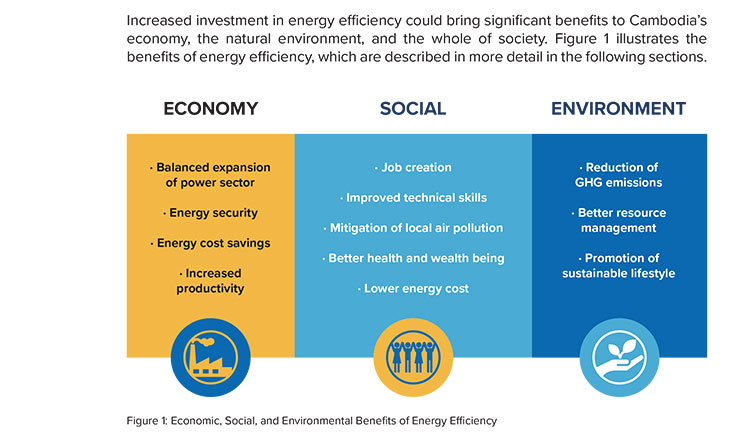Energy efficiency can create 500K jobs in Cambodia
As many as 500,000 additional jobs can be created in Cambodia by 2030 through energy efficiency measures and a family living in Phnom Penh can cut up to $545 annually from the electricity bills through effective energy saving methods, said a recent United Nations Development Programme (UNDP) study.
In a report titled “Green Economic Growth in Cambodia As A Covid-19 Response”, UNDP said the steps for energy efficiency will also contribute to the government’s effort in making electricity affordable through tariff reduction.
In the case of households, electricity bills can be substantially reduced by using power more efficiently, for example through efficient appliances and better-insulated buildings, the study said.
“An urban middle-class household in Phnom Penh could reduce their electricity bill by $545 a year by using efficient LEED lighting and energy-labelled refrigeration and cooling equipment,” the report pointed out. An added attraction is that the money saved in electricity costs can be used for purposes such as education and health.
According to the International Energy Agency (IEA), energy efficiency is the first step toward a sustainable global energy system. Investments in energy efficiency have also one of the highest job creation potentials out of all sustainable Covid-19 recovery measures.
Even before the Covid-19 crisis, more than 3.3 million people held jobs in the energy efficiency industry in the US and Europe alone. Most of them were employed by small and medium-sized businesses.
In the case of Cambodia, more than 500,000 additional jobs could be created by 2030 if the country follows the green industry scenario, the study said.
Establishing a National Energy Management System (EMS) can also help industries reduce their electricity cost and build capacities of the local workforce, creating new jobs such as energy managers or auditors.
Promoting energy management and other energy-efficient technologies in major industries (including garment, brick, food and beverage) with an estimated investment of $90 million will result in saving of $276 million until 2030, the report said.
Adopting energy efficiency measures in large-scale public infrastructure investment areas can also generate more jobs. For instance, India’s Street Lighting National Programme has upgraded around 11 million streetlights with efficient LEDs and generated 13,000 jobs, while reducing greenhouse gas emissions by five million tonnes per year, the report said.
The UNDP recommendations for Cambodia include converting public buildings to highly energy efficient, promoting low-energy consuming affordable housing, green city concept for reducing the urban heat island effect, smart and energy-efficient public street lighting, smart electric grids and electric vehicle charging infrastructure, public transport infrastructure and creation of cycling lanes and pedestrian zones.
Regarding the financing options for energy-efficient projects, the report said the Asian Development Bank (ADB) is working closely with the Ministry of Mining Energy (MME) to assess the energy-efficient market and it has supported the finalisation of the National Energy Efficiency Policy (NEEP).

In this context, ADB has also shown willingness to provide loans to Cambodia’s government to develop a sustainable energy efficiency market. Once the NEEP is in place, other international development banks and funds might also be willing to join.
Another vehicle for loans could be the ‘Green Financing Institution’ developed by Mekong Partners with USAID and the Green Climate Fund (GCF). The Green Financing Institution is envisaged to support and enable Cambodia’s shift towards a greener economy and society.
Issuing green bonds can also be effective as a financing method. A green bond is a fixed-income instrument designed to support specific climate-related or environmental projects. Green bonds typically come with tax incentives to enhance their attractiveness to investors.
The International Energy Agency (IEA) recently finalised economic modelling of green recovery measures in response to the Covid-19 crisis. It found that energy efficiency in buildings and industry, together with solar energy, creates the most jobs per million dollars of investment. On average, these measures create between 10 and 15 jobs for every one million dollars invested, the report said.
According to EnergyLab Cambodia, solar power is now the cheapest available form of electricity in the world and by removing the over-reliance on costly oil and coal-fired power plants and raising power generation from renewable sources including solar to 35 percent of total power by 2040, Cambodia can ensure a secure energy future for the next generation.
“Cambodia has over 40GW of solar power potential and excellent irradiation resources,” Bridget McIntosh, founder of EnergyLab Cambodia told Khmer Times, while urging the government not to go ahead with the proposed coal plants.
Source: https://www.khmertimeskh.com/501128444/energy-efficiency-can-create-500k-jobs-in-cambodia/


 English
English




